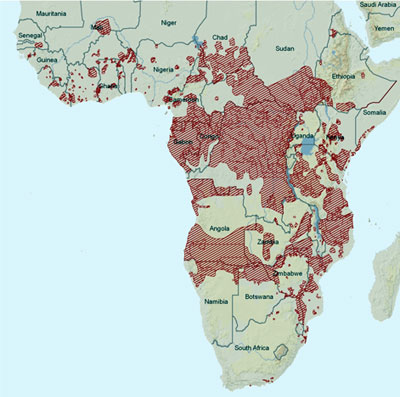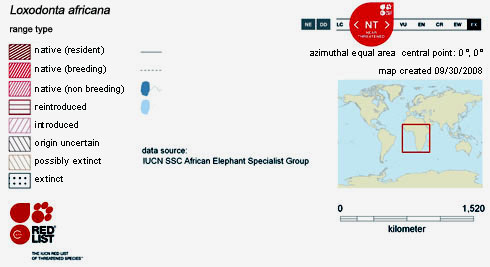Distribution and habitat


Distribution
The current range of the African elephant is Africa, south of the Sahara. It occurs in about 35 African states.
The species formerly extended into North Africa up to the Mediterranean coast. In West Africa, only thinly scattered, small populations remain. Central African rainforests still harbour substantial, largely continuous populations of L. a. cyclotis.
Savannah elephants, L. a. africana, occur in East and southern African savannas down to northernmost Namibia, Botswana, Zimbabwe and South Africa (with a large gap in central Angola and neighbouring areas).
Habitat
Although occupying exclusively tropical and subtropical zones, African elephants live in a wide range of habitats, including:
- Evergreen forests
- Dry deciduous forests
- Savannas (mixed woodland and grassland mosaics)
- Semi-deserts
They are essentially mixed feeders, so accessibility to a wide range of plants, and to water within one day’s walk, are essential prerequisites.
Estimates of natural animal density are hard to make. The carrying capacity will also vary enormously with the environment. In general, an area of about 2 mi2 (5 km2) per animal is probably typical in the wild, although the figure may be as high as 7.7 mi2 (20 km2) in rainforest habitats.
In many areas where they live, elephants are the dominant mammalian species in terms of biomass, and have a major ecological role. Their massive dung production recycles nutrients back into the soil. They can disperse seeds and fruits over wide distances,
Are elephants changing their own environment?
Elephants’ habit of destroying trees has led to debate about their role in changing their own environment. In some parts of Africa, elephants have transformed wooded areas into open grassland. However it us likely that, originally, such phenomena formed part of a natural cycle, with long-term balance between different habitats.
If a high number of elephants in one area caused a reduction in the tree density, either the elephant population would limit its own reproduction, or the animals would migrate to another area, allowing regeneration of woodland. In some areas even today, vegetation regeneration seems to keep pace with elephant feeding; it is primarily in savanna habitats, and particularly where elephants have been constrained within the boundaries of reserves, that problems arise, and in the present situation these are certainly important issues for conservation.
Many other factors, such as fire and climate change, also contribute to the balance between elephants and their habitats. In the severe drought of 1970-71, thousands of elephants died in Africa as a result of food and water shortage.